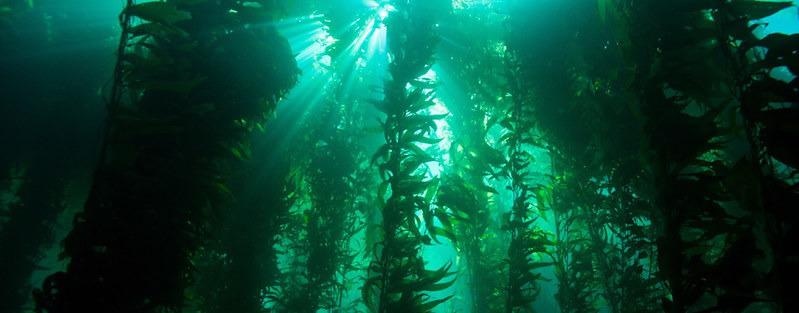Throughout the world, huge kelp forests have battled to stay healthy the past few years along with some fading altogether.

Most kelp forests around the world’s coastlines are struggling due to climate change, but a swath of kelp forest in Patagonia has been thriving. Its success is thanks to marine cold spells, according to a new study in AGU’s Journal of Geophysical Research-Oceans. Image Credit: NOAA.
However, along Patagonia’s rough southwestern coast, giant kelp is thriving, displaying exceptional stability for nearly 200 years. A new study performed indicates that frequent marine cold spells could help to keep kelp happy.
Scientists have discovered that the southwestern giant kelp forests have not faced an extreme marine heat wave since 1984 and, indeed, the area has had even marine cold spells that are turning out to be highly intense.
From 2014 to 2019, the region experienced highly severe and extreme cold spells compared to the rest of the study period. High wind activity and glacial melt could describe such rapid and localized cooling events.
Giant kelp forests are situated along a quarter of coastlines from the equator to the high latitudes and are considered crucial species for their ecosystems, among the world’s most productive and biodiverse.
Heat waves have the potential to bring changes in other species that are around, like sea otters and sea urchins who tend to snack on them in the Northern Hemisphere; and if the otters vanish, urchins could overgraze the kelp forests.
Furthermore, high sea temperatures can cause stress to the kelp directly, as they are the best-adapted ones for cooler waters. In central and northern Chile, unrestricted direct harvesting by humans has been responsible for destroying kelp forests. Such risks have dissipated several kelp forests the past few years and resulted in a 2% loss of kelp forests annually.
However, Patagonia’s giant kelp forests, situated on the southern tip of Chile, look just similar to how they were in the early 20th century. This has been felt by the marine geographer Alejandra Mora-Soto, lead author of the new study.
The study has been recently reported in the journal AGU’s Journal of Geophysical Research-Oceans.
In her early work, Mora-Soto compared nautical charts as far away as Charles Darwin’s Beagle expedition to advanced satellite imagery of kelp and discovered that little had changed. This happened in spite of human influence and climate change.
“It’s a very persistent ecosystem, so the question was, ‘Why has this particular kelp forest survived so long?’” stated Mora-Soto, who is at present affiliated with the University of Victoria in British Columbia but finished this research while at the University of Oxford.
To determine this, Mora-Soto and collaborators examined sea surface temperatures from the southernmost 800 miles of South America’s coastlines from 1981 to 2020, in search of cold spells and marine heat waves. While heat waves emphasize kelp forests, they wondered what effect cold spells would have.
Glacial melting means more cold water entering the ocean environment. This can create very short peaks in cool temperatures, from a few days to two to three weeks.
Alejandra Mora-Soto, Study Lead Author and Marine Geographer, University of Oxford
Cool waters can serve as air conditioning for the kelp, thereby controlling their surroundings and maintaining convenient temperatures. Wind patterns that tend to impact ocean surface circulation and heat fluxes, or cold water traveling across Antarctica could also be factors, added Mora-Soto.
The heat wave story has emerged over the last ten years, but the cold spell story hasn’t been told. I think that’s quite interesting to think about in terms of kelp resilience.
Kira Krumhansl, Marine Ecologist, Bedford Institute of Oceanography
Krumhansl added, “It’s neat to understand that there’s a different climate signal here, where the climate is not warming as rapidly and waters are staying closer to temperatures the kelp can tolerate. It appears to be leading to their resilience and persistence.”
Krumhansl was not involved in the new study.
Keeping Kelp Happy
The perspective for such kelp forests might stay bright, for at least the immediate future. Present climate and ocean models forecast the Southern Ocean, the waters in which such thriving kelp forests live will prevent warming in a considerable manner.
However, as the increase is found in glacial melt, that freshwater could bring with it sunlight-blocking sediment, which is known to be different sets of nutrients and also too-cold temperatures.
Mora-Soto added, “If there’s ice in the system, that could be very stressful for kelp.”
Researchers are yet to have well-defined windows for how long diverse kelp species have the ability to bear extremely cold water.
Mora-Soto emphasized the need for safeguarding such especially successful kelp forests.
Mora-Soto stated, “In Southern Patagonia, most of the lands surrounding the kelp forests are protected, but not necessarily the waters. And in the northern regions of Chile, kelp forests are harvested for the alginate industry, creating underwater deserts in environmentally favorable conditions. I hope environmentalists, NGOs, local communities and the current government can help make the protection of kelp something real.”
I think we’re at the cusp of learning more and more about what value kelp forests have for humans. They tend to be underappreciated, but they are amazing ecosystems, just beautiful to be in. And they provide a lot of benefits with focusing on and protecting.
Kira Krumhansl, Marine Ecologist, Bedford Institute of Oceanography
Journal Reference:
Mora-Soto, A., et al. (2022) A Song of Wind and Ice: Increased Frequency of Marine Cold-Spells in Southwestern Patagonia and Their Possible Effects on Giant Kelp Forests. JGR Oceans. doi.org/10.1029/2021JC017801.